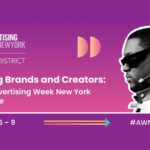By Natalie Hanson, Account Director at Jordan Digital Marketing
Meta had their annual B2B Summit this week and covered some of their new tools/capabilities for B2B advertisers on their platforms. Here are a few of the big highlights:
- Product Innovations: Updates to Instant Forms (Conditional Logic!), Gated Content, New Messaging Features including options for leads to ‘request a call back’
- CRM integration with Conversions API to train algorithm according to lead quality
- 17 new B2B targeting segments
- Learnings on how AI can help with B2B strategy
- Measurement methods for B2B
Over the past couple of years – basically, ever since iOS 14 cratered tracking and set Facebook advertisers back on their heels – Facebook has made steady improvements in its viability for B2B advertising. This year’s updates continue that trend, with the biggest releases (in my view) helping advertisers improve lead quality, not just quantity.
There’s a LOT to dig into, so let’s start with…
The updates that excite me most
- The ability to integrate lead-quality data into the Conversions API is definitely the most exciting to me. The update allows advertisers to upload down-funnel events from their CRM to optimize towards qualified leads + down-funnel conversions – leading to higher quality and more impactful results. We’ve seen Offline Conversion Tracking (OCT) lead to huge pipeline gains for clients on Google and Linkedin, so I’m stoked Facebook is extending this feature with CAPI. They’ve had Offline Conversions available for a while now, but I would expect this product innovation to be even more enhanced since it’s more B2B-specific.Facebook, if you’re listening, my next wish is the ability to optimize toward multiple conversions for each campaign or ad set, like we can on Google. It would be super valuable for B2B advertisers to allow campaigns to learn off of signals from multiple stages of the funnel – especially with the lower volume and slower learnings that tend to come with B2B.
- Conditional Logic within new Instant Forms (for lead gen) is also a really welcome release. I think personalized experiences are going to continue to become more and more important. Businesses and users aren’t looking for one-size-fits-all; they want solutions that best fit their specific needs. Conditional Logic dynamically creates ‘custom experiences’ and flows based on how users answer specific qualifying questions.Lead filtering, which lets advertisers add a pre-qualifying (or disqualifying) question at the beginning of the lead flow, is also available to further help control the quality of responses and data. It’s all about quality over quantity for B2B!
Targeting segments that caught my eye
Among the 17 new segments available for B2B targeting, a few ‘Creator’ (read: influencer-focused) segments stood out to me; it makes sense that Facebook would nudge businesses to leverage ‘Creators’ more since they use the Meta platforms so much. Whether that’s useful to B2B companies or not remains to be seen.
Company size and revenue segments, on the other hand, stand out as what I think will be the most used and probably the first ones I’ll test. Company size and revenue tend to be a common qualifying characteristic for a lot of our clients on what types of businesses are in their ICP, so the ability to isolate the right segments could be impactful.
The benefits of the new measurement methods for B2B (and Facebook)
Advertisers struggling to move away from last-touch conversion attribution will get a push in the right direction here; Facebook’s measurement updates will help show the full attribution picture. This is critical for B2B because of its long buying cycles (users almost never convert with the first ad); demand creation, lead generation, lead nurturing, latency, and cross-channel engagement are all part of the real-life customer journey and need to be part of the measurement picture as well. (A frequent path: users first become aware of your business and download a resource on Facebook to learn more – and then convert three months later by searching for your business name on Google.)
A full-funnel approach that focuses on warming users throughout the funnel, which is now much more measurable on Facebook, also tends to lead to higher-quality leads. If users are educated first, they’ll drop out of the funnel if it’s not a good fit or the product/service wouldn’t work for them – they’d essentially weed themselves out before the sales team does. In theory, it would also lead to less education and warming that needs to be done on the sales team’s end since they already know about the business and what it provides.
The combination of all of these tools makes it possible for advertisers to see both the short-term value (form fills, leads) and the long-term value (down-funnel conversions, closed deals) that Facebook ads played a part in.
Facebook’s standing in the B2B advertising landscape
Facebook has traditionally been D2C- and B2C-focused and generally seen as second to LinkedIn in the social B2B space. (This makes sense: LinkedIn’s targeting options are extremely advanced because they have career and company-based data native to their platform.) These releases are definitely a step in the right direction and a shot across the bow at LinkedIn, but at this point, Facebook still has hurdles to clear.
Perhaps the biggest hurdle: Facebook users just don’t actively update their employment info (company, job title/role, email, etc.), so unless they figure out an incentive for users to update that information in their profile regularly (or figure out a way to connect with LinkedIn for that information to transfer over to their Facebook / Instagram profile), they’ll stay a step behind.
That said, advertisers will spend where they see performance, and these updates definitely add more incentive for B2B advertisers and companies to consider testing the platform – whether they’ve previously ignored it or struggled to see results on it. Business buyers and leadership are becoming younger, and more of them are active on these platforms and thinking about work outside of ‘work’. Facebook does have a chance to be a bigger player in B2B if they keep updates like these coming – which would be in advertisers’ best interests as well.








